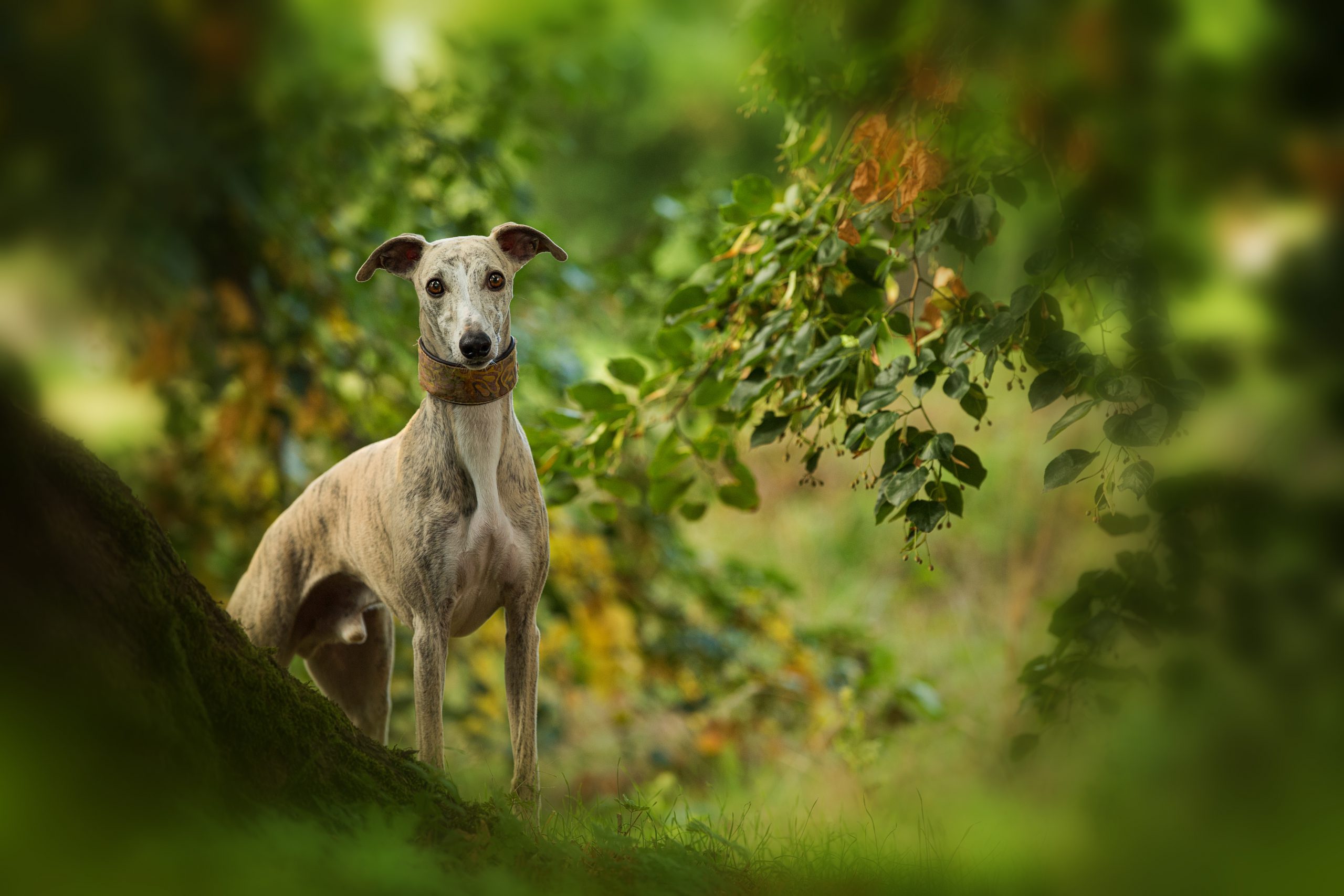
Whippet: preliminary findings
The Whippet community has been off to a great start in assessing the biodiversity of their breed by submitting 54 Whippets to UC Davis for analysis. Dr. Pedersen was sent their data last week and has created a preliminary report. He states, “The anticipation is that the 54 dogs tested will define 90% or more of the known autosomal alleles and DLA class I and II haplotypes for the breed. This is sufficient to provide a reasonable assessment of genetic diversity in the breed.” However, more Whippets from all over the world should be tested before the final report is created. Click here to add your Whippet.
How inbred is the typical Whippet?
One aspect of the UC Davis canine diversity test is a calculation that estimates how inbred a dog is. This estimate, called Internal Relatedness or IR, is a positive measure from 0 to 1 when a dog is inbred, and a negative measure from 0 to -1 when the dog is outbred. An outbred puppy would inherit genetics from its sire that were very different from those it inherited from its dam. An inbred puppy would inherit many of exact same genetics from both dam and sire. Being outbred reduces the likelihood of known and unidentified recessive component diseases expressing in individuals.
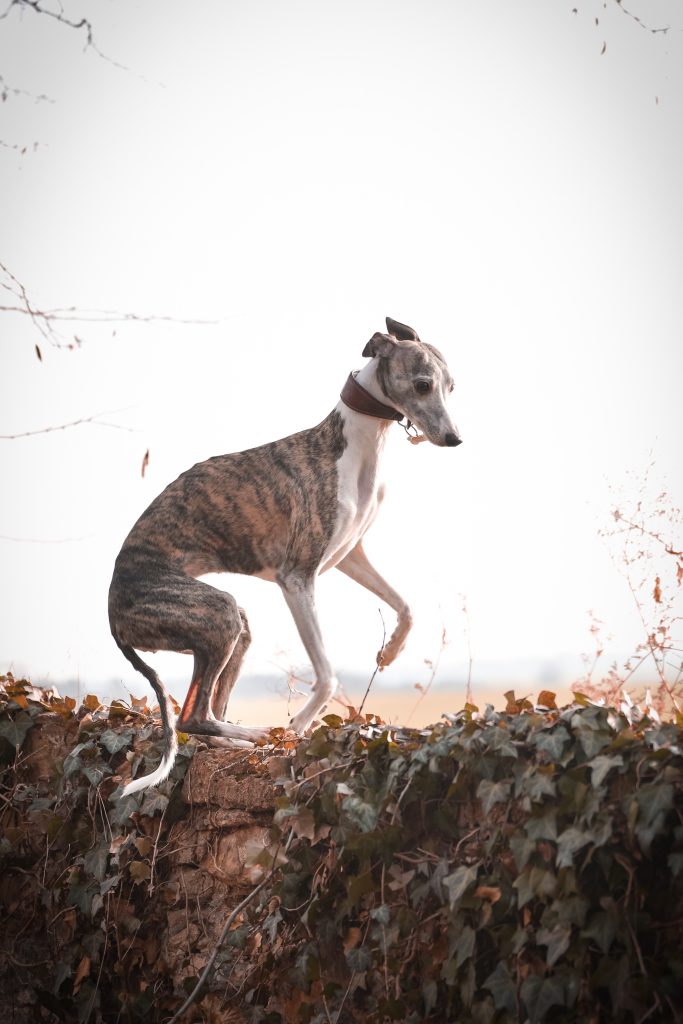
So, how inbred or outbred are the individuals in the Whippet breed?
From the report:
The 25% of most outbred dog in the population had an IR scores of -0.046 to -0.245, while the 25% of most inbred dog in the group had an IR score of 0.093 to 0.247, while the mean (average) IR score for the group was 0.021. Therefore, IR values give a different picture than seen with the population average scores from the standard genetic assessment (Table 2).
…
The most inbred dog in the group was interrelated to the same degree as offspring of full sibling parents.
Additionally, Dr. Pedersen further noted later in the report that “Therefore, if this group of dogs were found among modern village dogs, three-fourths of them would be considered equally or more inbred than offspring of full sibling village dog parents.”
To translate – a portion of the breed has very high levels of inbreeding, and because we can’t necessarily detect this without DNA testing and analysis, they could benefit from predictive software aiding in selection of breeding mates, to ensure that future breedings are not too close, risking health as a result.
How much biodiversity exists in the Whippet today?
Dr. Pedersen analyzes the data collected from the VGL canine diversity test in many different ways in order to assess the total amount of biodiversity within each breed. Many of these measures together give us an overall picture of the state of the breed and as a result we can make informed decisions on breed management.
The best explanation I’ve yet read is from BetterBred Founder Natalie, and as a result we will share it again here!
Most breeders think of DNA as coming in two options- a good gene, or a mutant gene – like it is in many DNA tests. In fact, there can be many versions of each gene or (in this case) marker in a single place on the DNA – like a t-shirt that is available in different colors. The more variants there are, the more information we have about the population genetics of a breed. In more inbred breeds, there are fewer variants for each marker. So to use our analogy, an inbred breed might have only a few colors available in t-shirts, whereas a diverse breed will have t-shirts in many colors. Apart from the relatively small number of genes that make up specific, visible breed traits, the rest of the gene pool is generally healthier when there’s a lot of variation for each marker.
Unfortunately when breeders select too strictly for too long and for very specific traits, there can be an unintended loss of variation in the parts of the DNA that thrive with more variation. A good way to assess whether that good variation has been impacted is by using the markers found in the VGL canine diversity test. Because they are considered neutral – or not associated with any specific known trait – they are great for assessing genetic diversity. In breeds with ample diversity, there will be lots of variations for each marker (lots of colors in the t-shirt drawer.)
But what if you have a breed without much variation? Well, this happens, and can happen quite often. In this case the best thing breeders can do is try to make sure the variants that are in the breed are well distributed – so there are plenty of all of them in the breed. Imagine a t-shirt drawer with lots and lots of red t-shirts but only one blue t-shirt and one green t-shirt. If you lose one of the red ones, it doesn’t change much about the t-shirt drawer – there are lots of other red ones. But if you lose either the blue or green one, the variation is seriously diminished. If, on the other hand a third of the shirts are red, and a third are green and a third are blue, then it’s a lot harder to lose the existing variation in the drawer, even if you lose one once in a while, and even though there are only 3 colors.
The Whippet’s biodiversity
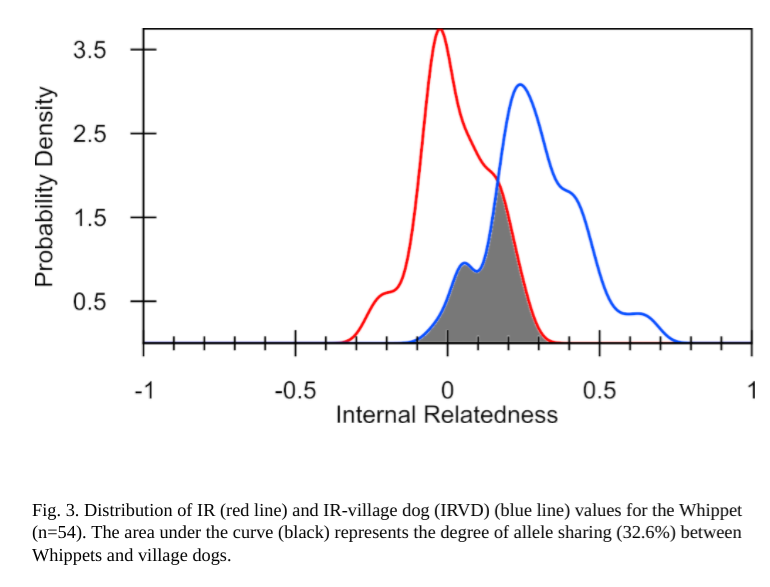
Another use of an individual’s inbreeding value: we can look at the inbreeding level of all individuals in the breed in aggregate – meaning the whole breed altogether. When a whole breed is very inbred on the same few ancestors, it can result in very little remaining biodiversity within the breed. Then, by adjusting those inbreeding values in comparison to the data from village dogs (often considered “ideal” for biodiversity), researchers can estimate the remaining biodiversity of a breed compared to all the diversity that once existed in dogs prior to breed formation.
So when this investigation was done for Whippet, what did Dr. Pedersen see?
The IRVD curve for the Whippets tested was shifted to the right of the IR curve, and the area of overlap was 32.6% (Fig. 3). This figure is close to the 39.5% of retained genetic diversity calculated from comparison with a somewhat different population, i.e., all canids ever tested at the VGL (Tables 1, 2). This level of retained village dog genetic diversity is lower than the 60% or so retained diversity observed in the Miniature/toy poodle or 54% in Labrador Retriever, and much higher than the 23% for Irish wolfhound, 15% in Doberman Pinchers and 7% in Swedish Vallhund. All pure breeds of dogs have come from relatively small founder populations, which has limited genetic diversity from the time registries were created and closed. Greatly varying amounts of genetic diversity may have been lost subsequently through artificial genetic bottlenecks such as cataclysmic events (e.g., world wars) or inbreeding for a specific show conformation (e.g., popular sire effects).
Dr. Niels Pedersen
This assessment indicates that there has been a depletion of genetic diversity in this breed compared to the “ideal”, but let’s look at the data another way:
A secondary way to estimate the loss of biodiversity due to breed formation and breeding choices post-formation is to look at the average number of alleles found at each tested locus and to compare those to the village dogs. When looking at the number of alleles found, we might consider two things: the average number of alleles found in total (Na), and the average number of alleles that are effectively contributing to the population (Ne – effective alleles). Going back to the t-shirt analogy above, say we have 10 t-shirts, and 8 of them are red and one is green and one is yellow. The total number of shirt colors is 3, however the majority color is red, therefore our “effective” t-shirt color would be only 1.
So, if we look at these numbers what do we find out about this population?

Using the 33-marker panel, the 54 Whippets had an average of 6.09 alleles/locus (Na). This is higher than for the Shiloh Shepherd (Na=4.0), Lakeland Terrier (Na=4.24), Swedish Vallhund (Na=4.91) and Irish Red and White Setter (Na=5.09); similar to the Llewellin Setter (Na=5.94) and Flat-coated Retriever (Na=5.94); but lower than large and genetically diverse breeds such as the Labrador Retriever (Na=7.33), Golden Retriever (Na=8.39) and Miniature Poodle (Na=8.91). However, the average number of alleles is less important than the number of alleles that have the greatest genetic influence on heterozygosity, a figure known as average effective alleles/loci or Ne. Ne in this group of dogs averaged 3.18 effective alleles per locus. Therefore, an average of three alleles at each locus contribute to most of the heterozygosity within the breed.
….The low Ne for Whippets suggests the need of for breeders to maintain current heterozygosity as vigorously as possible.
….
Dr. Niels Pedersen
On average, the alleles identified in this group of 54 dogs represented 6.09/15.4=39.5% of alleles known to exist in all canids tested at the VGL. This is higher than the Swedish Vallhund (31.9%) and Irish Red and White Setter (34.8%); similar to the Flat-coated Retriever (38.6%), Magyar Agar (40.4%) and Borzoi (40.9%); but lower than breeds such as the Golden Retriever (54.5%), Toy Poodle (55.6%) and Standard Poodle (58%).
This number predicts that the Whippet has retained 39.5% of the existing biodiversity available to canids; this number is comparable to the estimate from the IRVD, which estimated a retention of 32.6% of existing biodiversity.
Additionally, Dr. Pedersen discovered that the breed is only effectively using about 52% of it’s total available biodiversity (Ne/Na). How does a breed community increase this? They identify individuals who may have unusual genetics for the population, and work to preserve those genetics and redistribute them in the population at large.
Breed relationships
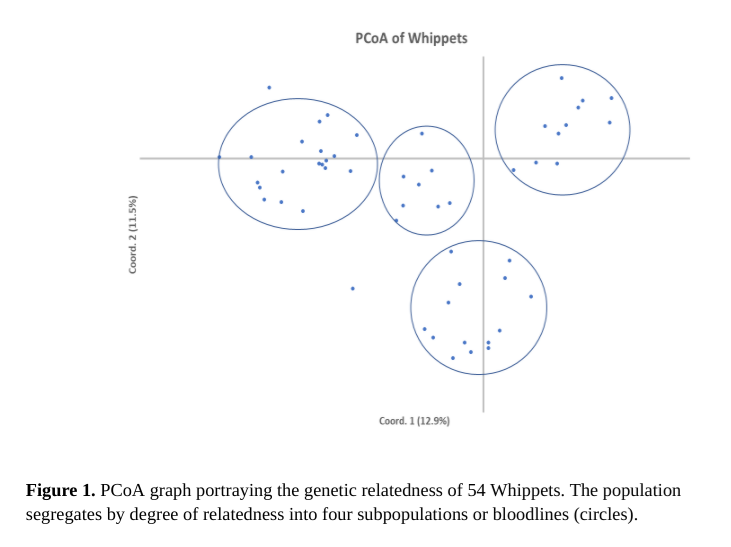
Another use of the data from the VGL canine diversity test is to see how the individuals within the population fit in relation to one another. What do we see when we look at this analysis, called the PCoA graph?
The 54 Whippets formed a single population (i.e., breed) divided into four genetically distinguishable subgroups by PCoA (Fig. 1). These subpopulations were comprised of dogs that were more related to each other than to dogs in the rest of the population. This is a common feature of bloodlines within a breed and an indication that the 54 dogs chosen for this analysis were as genetically diverse as possible and likely to be representative of the entire breed.
Dr. Niels Pedersen
This is the first time we have seen so many subpopulations within a breed. Will this continue to be evident as more Whippets are tested? Subpopulations like this make a breed seem very segmented, so Dr. Pedersen will look at other breeds related and distantly related to get a picture of how well the breed self segregates and relates to similar breeds.
Dr. Pedersen chose to compare the Whippet with Italian Greyhounds and Samoyed. In this comparison, the Whippets segregate tightly with one another. However, interestingly it seems there is some overlap between European Italian Greyhounds and Whippets.
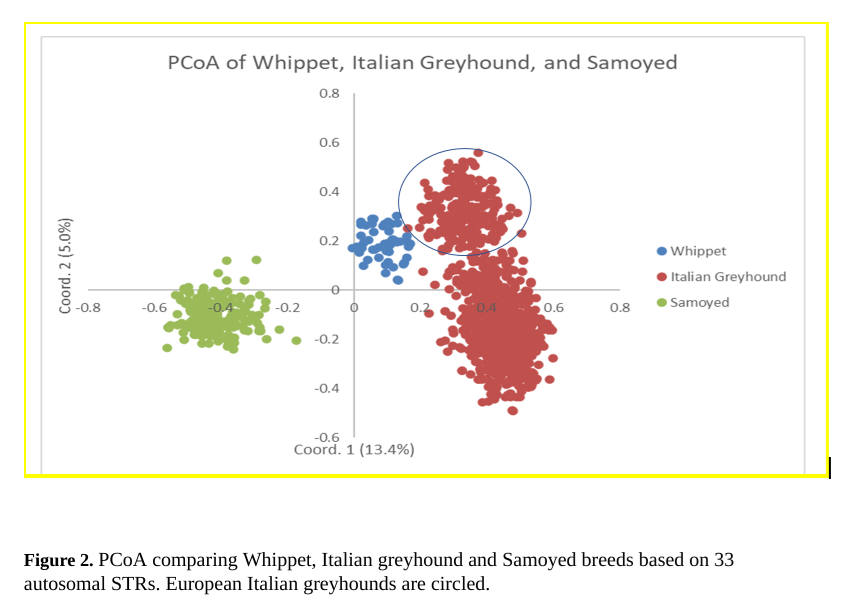
Figure 2 shows that Italian greyhound are composed of two varieties (European and North American) and all Whippets are closely clustered as a single breed and no longer divided into subgroups as in Fig. 1. Samoyeds, being genetically dissimilar are tightly clustered at a significant distance from the Whippet and Italian greyhound. It is also significant and expected that the Whippet and Italian greyhound are clustered nearest to each other, but it is even more significant that several Italian greyhounds, especially those from Europe, are clustering within or closely adjacent to Whippets. This suggests that some outcrossing has occurred more recently between these two breeds
Dr. Niels Pedersen
The immune system
The UC Davis VGL canine diversity test can identify more regions of the DLA than any other test available today. The Dog Leukocyte Antigen, called the DLA, is the region of the DNA that codes for the immune system in the dog. There are three regions, Class I, Class II and Class III. This test identifies both Class I and II haplotypes. (A haplotype is a tightly linked group of genes within an organism that is inherited as a group from a single parent.) To learn more about the DLA, read here.
From the report:
The 54 Whippets in this study possessed 16 DLA class I and 9 DLA class II haplotypes (Table 5). Three class I (1247-1249) were unique to the breed and the rest shared with several other breeds (Table 6). All class II haplotypes have been recognized in other breeds (Table 6). No class I or II haplotype was dominant in the breed, somewhat different from many other breeds. This indicates that the breed has evolved from a relatively large and diverse founder population. The lower proportion of class II to class I haplotypes was unusual and was previously seen in the Borzoi. The number of DLA class I and II haplotypes found in these 54 Whippets was average compared to many other breeds studied to date. The numbers of DLA class I (n=16) and II (n=9) haplotypes found in Whippets were higher than the Swedish Vallhund (6,4) and Shiloh Shepherd (7, 6); similar to the Giant Schnauzer (14/15), Samoyed (13/12) and Shiba Inu (16/15); and much lower than Golden Retriever (26/23) and Miniature Poodle (33/ 23).
Dr. Niels Pedersen
In summary on the DLA: The Whippet have an average amount of DLA in comparison to other breeds. Unlike many other breeds, there is no single DLA haplotype in either the Class I or Class II regions that is in majority. Most dog breeds have 1-2 DLA haplotypes that make up the majority of the DLA haplotypes sampled. More haplotypes may be found as more Whippets are tested.
Conclusions
The following conclusions from Dr. Pedersen sum up the findings from the 54 tested Whippet.
Whippets have maintained a below average level of genetic diversity since founding.
Dr. Niels Pedersen
This knowledge is impetus for breeders to be as diligent as possible in maintaining
existing diversity through the following generations. A lack of genetic diversity is not in
itself bad, providing the founder population was relatively free of deleterious genetic
traits and breeders have been judicious in avoiding any artificial genetic bottlenecks that
may cause either a loss or imbalance of original diversity. The breed is surprisingly clear
of breed-specific heritable disease traits and enjoys a good lifespan. Breeds that lack
genetic diversity must be managed much more closely to avoid further loss of genetic
diversity and have less leeway in dealing with simple recessive or complex polygenic
disorders that might arise. Elimination of deleterious traits may result in loss of genetic
diversity, especially when diversity is already low.
Based on this report, the Whippet has below average biodiversity. It will be of great importance to conserve the existing biodiversity so further depletion does not occur due to random loss of alleles – called genetic drift. Breeders can do this by testing their dogs and placing a priority on healthy dogs with less well represented genetics in comparison to the rest of the population, provided they are good representatives of the breed. Using our tools designed to identify these individuals, Average Genetic Relatedness (AGR) and the Outlier Index (OI), breeders can assess these dogs for selection as mates, as well as simulate what to expect in potential litters. Special attention might be warranted to preserve the less typical DLA haplotypes so they are not lost to genetic drift.
Do you own a Whippet and want to add them to the sample? We particularly need samples from outside the US. Click here to add your Whippet to the study!
 Previous Post
Previous Post Next Post
Next Post


